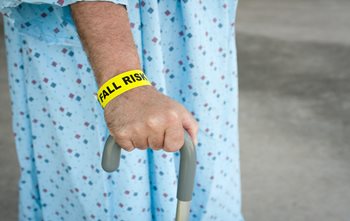
Guidance on Urinary Symptoms and Fall Risks
Among nursing home residents, falls are a leading cause of injuries. Falls are typically linked to underlying health problems, such as dementia, mobility impairment or medication side effects. Urinary symptoms (US), such as urgency, frequency, nocturia, etc. are associated with an increased likelihood of falling. Residents with US often engage in potentially risky behaviors, such arising from bed several times during the night, mostly under conditions of poor illumination, to urinate. To make matters worse, residents often need to hurry to the toilet in order to not wet themselves, which increases their risk of falls. Consequently, addressing US represents a potential target for interventions aimed at reducing falls in nursing home residents. Unfortunately, while residents with US have repeatedly been shown to be at significant risk for falls, focusing on US alone, without addressing the resident’s fall risk status, has not resulted in any decrease in fall risk. This course discusses the causes of falls and fractures, and the urologic conditions that increase their risk, and focuses on how nursing staff can potentially prevent falls by addressing US and vice versa, on how reducing fall risk can benefit residents with US.
Questions? Check out our FAQs page and How Online IV Certification Works!
Objectives
Upon completion of this course the participant will be able to:
- Explain the relationship between urinary symptoms and fall risk.
- Identify Age-related changes in the urinary system.
- Recognize the root causes of urinary symptoms.
- List common reversible causes of bladder loss.
- Name specific types of chronic urinary incontinence.
- Describe the screening and assessment process for both bladder loss and fall risk.
- Summarize management strategies for bladder loss and fall risk.
Curriculum
Chapter 1: Introduction
Chapter 2: The Urinary System
Chapter 3: Causes Of Urinary Symptoms
Chapter 4: Screening And Assessment
Chapter 5: Management Of Urinary Symptoms
Chapter 6: Management Of Fall Risk
Chapter 7: Environmental Strategies
Chapter 8: Case Study
Chapter 9: Course Summary
Chapter 10: Appendix
Chapter 11: References
- California Bill 241
- Implicit Bias in Healthcare
- What is Implicit Bias?
- Implications of Implicit Bias in Healthcare
- How to Reduce Implicit Bias
Price: $24.00
Contact Hours: 2

Course Author

Rein Tideiksaar
Rein Tideiksaar, PhD, PA-C, or Dr. Rein as he is commonly referred to, is the president of Fall Prevent, LLC, Blackwood, New Jersey, a consulting company that provides educational, legal, and marketing services related to fall prevention in the elderly.
Dr. Tideiksaar is a gerontologist, which is a health care professional who specializes in working with elderly patients, and a geriatric physician's assistant. He has been active in the area of fall prevention for over thirty years.
Course Accreditation
See our Accreditation Statements page to view our accreditation information.